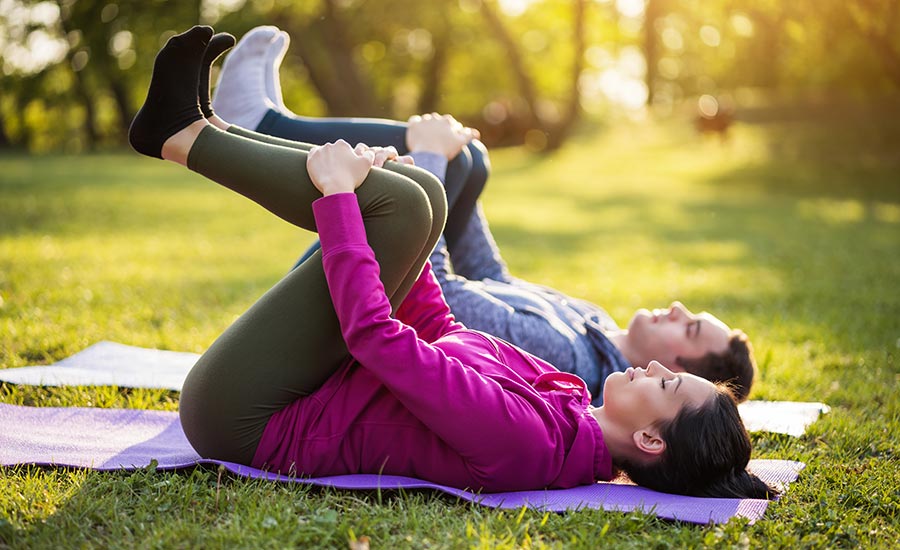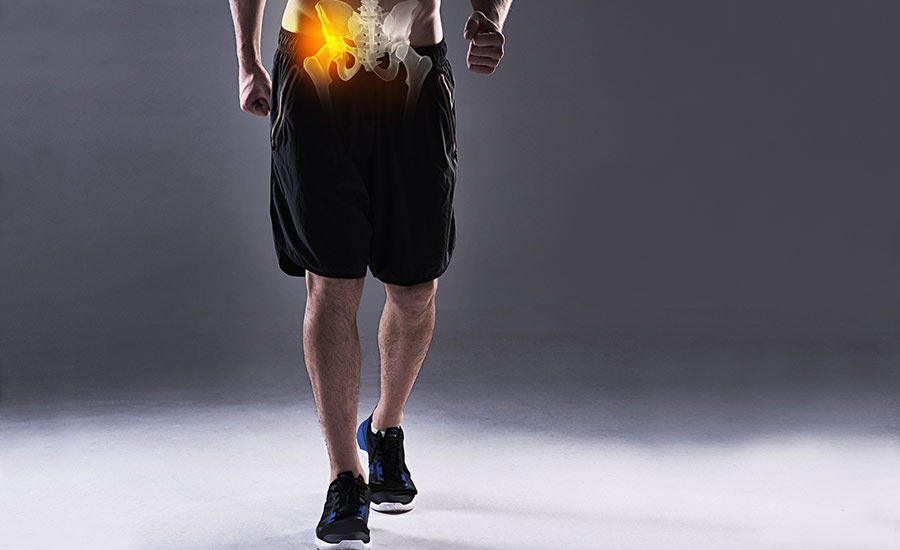
Up to 40% of people experience sciatica pain — and the likelihood increases with age.
In some cases, sciatica pain may require surgical treatment from an orthopedic specialist, while in other cases, pain can be managed with stretches, exercises and other conservative treatments.
We created a list of 15 effective sciatica stretches and exercises that you can use to alleviate your pain and improve your mobility to prevent sciatica pain.
If conservative treatment options aren’t working for you, get to know our orthopedic physicians at OrthoEast and schedule an appointment to find pain relief.
What Is Sciatica?
Sciatica is a type of pain that is caused by irritation or compression of the sciatic nerve, which is the largest nerve in the human body.
The pain can range from a mild ache to a sharp, shooting sensation that radiates down the leg, making it difficult to walk or even sit comfortably.
The sciatic nerve runs from the lower back down to the legs and feet, and when it becomes irritated or compressed, it can cause a wide range of symptoms, including:
- Mild pain that moves from the lower back straight down to the legs and feet
- Numbness or tingling in the legs and feet
- Weakness in the legs and feet
- Difficulty standing up or walking
- Shooting & sharp pain that affects mobility and quality of life
In around 90% of cases, the condition is caused by a bulging or a herniated disc, with nerve root compression. However, it can also be caused by spinal stenosis, degenerative disc disease, and other conditions that put pressure on the sciatic nerve.
In many cases, sciatica pain will resolve on its own within 4-6 weeks with conservative treatments, such as gentle exercise and stretching.
Sciatica Stretches for Pain Relief
Stretching can help to alleviate tension and pressure in the lower back and legs and improve flexibility and mobility, to help you find pain relief.
The top 10 sciatica stretches for pain relief include:
Hamstring Stretch
This stretch helps to loosen tight hamstrings, which can offer relief from sciatica pain.
To perform this exercise:
- Lie on your back and lift one leg straight up, while keeping the other leg bent
- Hold the back of your thigh with both hands and gently pull towards your chest
- Hold for 30 seconds, then switch legs
Pigeon Pose
The pigeon pose helps to stretch the hip flexors and the piriformis muscle.
To perform this exercise:
- Start on your hands and knees
- Bring one leg forward so that your knee is bent and your foot is near the opposite hip
- Extend the other leg behind you and lower yourself down onto your forearms
- Maintain the position for 30 seconds
- Repeat on the other side
Piriformis Stretch
The piriformis muscle is located in the buttock area and it can become tight and inflamed, causing sciatica pain. This stretch can help loosen your muscles to reduce pain caused by stiffness.
To perform this exercise:
- Sit or lay on the floor with your legs out in front of you
- Cross one leg over the other, placing your foot on the opposite knee
- Pull the crossed knee towards your chest gently and try to pull it until you feel a good stretch
- Hold for 30 seconds, then switch legs
Child’s Pose
The child’s pose is a relaxing stretch that helps to release tension in the lower back and hips.
To perform this exercise:
- Start on your hands and knees
- Sit back on your heels with your arms outstretched in front of you
- Maintain the position for 30 seconds
Knee-to-Chest Stretch
The knee-to-chest stretch targets the lower back muscles, which can also contribute to sciatica pain when tight.
To perform this exercise:
- Lie on your back with your legs extended straight ahead of you
- Bring one knee towards your chest
- Hold it there with your hands for 30 seconds
- Repeat on the other leg
Seated Spinal Twist
The seated spinal twist helps to stretch the lower back and hips and reduce stiff muscles and improve flexibility.
To perform this exercise:
- Sit on the floor with your legs straight out in front of you
- Bend one leg and place your foot on the other side of your opposite knee
- Twist your torso towards your bent knee
- Maintain the position for 30 seconds
- Repeat on the other side
Cat-Cow Stretch
The cat-cow stretch helps to loosen the muscles in the lower back and hips, to reduce inflammation and improve mobility.
To perform this exercise:
- Start on your hands and knees
- Switch positions by arching your back and rounding your back
- Move slowly and smoothly
- Maintain the position for 30 seconds
Seated Figure-Four Stretch
The seated figure-four stretch helps to stretch the piriformis muscle and reduce pain caused by stiffness.
To perform this exercise:
- Sit on the floor with your legs straight out in front of you
- Bend one leg and place your ankle on the opposite knee
- Gently pull the bent knee towards your chest until you feel a stretch in your hip area
- Try to maintain the position for 30 seconds, then do the same on the other side
Lying Spinal Twist
The lying spinal twist helps to stretch your lower back and hips and improve flexibility.
To perform this exercise:
- Lie on your back with your legs straight out in front of you
- Bend one of your legs and position your foot on the ground
- Slowly twist your torso towards your bent knee
- Maintain the position for 30 seconds
- Repeat on the other side
Lunge Stretch
Incorporating the lunge stretch into your routine can effectively stretch your hip flexors and provide relief from sciatic nerve pressure.
To perform this stretch:
- Stand with your feet apart, keeping them at shoulder width
- Step one foot forward and bend your knee, while keeping your other foot behind you
- Straighten your back and make sure your hips are facing forward
- Try to hold the stretch for around 30 seconds, then switch legs and repeat
Choose a few exercises that specifically target the areas where you are experiencing the most pain or discomfort, to start. Gradually increase the intensity or add more movements as you become more accustomed to the exercises.
It’s important to maintain the proper form and technique while performing these exercises. You should feel a stretch or slight discomfort, but it should not be painful. If you experience any pain, discontinue the exercise immediately and contact our OrthoEast team to schedule a consultation with our spine specialists.
Sciatica Stretches for Seniors
The body becomes more susceptible to injuries and pain with age. While some exercises may help reduce pain for younger age groups, they could end up worsening the problem for others.
If you’re a senior suffering from sciatica pain, try these stretches to find relief:
Chair Hip Stretch
This stretch helps to increase flexibility in the hip muscles and can be performed while sitting down.
To perform this exercise:
- Take a seat at the edge of a chair, making sure your feet are flat on the ground
- Rest your hands on your knees
- Slowly bring your right ankle up to your left knee
- Press your right knee down towards the floor
- Make sure you hold for 30 seconds so you can feel the stretch, then switch sides
Standing Hip Flexor Stretch
This stretch can help improve spinal flexibility and reduce lower back pain.
To perform this exercise:
- Stand facing a chair or wall for support
- With one foot take a step back and start bending your front knee
- Keep your back leg straight
- Move your hips forward until you feel a stretching sensation
- Try to hold the stretch for 30 seconds before repeating the other side
Leg Cross Stretch
This stretching technique focuses on the glutes and hips and can be performed while seated.
To perform this exercise:
- Take a seat in a chair, ensuring that your feet resting flat on the ground
- Rest your hands on your thighs
- Cross your right ankle over your left knee
- Apply gentle pressure on your right knee to intensify the stretch.
- Try to hold the stretch for 30 seconds before switching to the other side
Seated Forward Fold
This position is beneficial in stretching the lower back and hamstrings.
To perform this exercise:
- Take a seat in a chair, ensuring that your feet resting flat on the ground
- Rest your hands on your thighs
- Slowly hinge forward at the hips
- Bring your chest towards your thighs
- Maintain a straight back and hold the stretch for a duration of 30 seconds.
Wall Hamstring Stretch
This stretch helps to increase flexibility in the hamstrings and can be performed while standing up.
To perform this exercise:
- Stand in front of a wall and position your hands on the wall at shoulder level
- Step back with your left foot and keep your left leg straight
- Bend your right knee and lean forward, while keeping your back straight
- Lean forward slowly until you feel a stretch in your left hamstring
- Try holding the stretch for 30 seconds and after that switch sides
Best Exercises For Sciatica Pain
In addition to gentle stretches that help improve flexibility, certain exercises can help ease or prevent sciatica pain by reducing inflammation and promoting healthy circulation.
Effective exercises and activities for sciatica pain include:
- Walking: Walking is a low-impact exercise that can help improve circulation, flexibility, and mobility, all of which can help relieve sciatica pain.
- Swimming: Swimming is another low-impact exercise that can help relieve pressure on the spine and sciatic nerve while strengthening muscles.
- Stationary biking: Stationary biking is a great low-impact exercise that can help improve circulation and flexibility, while reducing pressure on the spine and sciatic nerve.
- Yoga: Yoga is a great way to improve flexibility, strength, and balance, which can all help relieve sciatica pain. Some yoga poses, like downward dog and pigeon pose, can be particularly helpful for stretching the hips and lower back.
- Core strengthening exercises: Strengthening the core muscles can help improve your posture and support the lower back, which can help relieve sciatica pain. Examples of core exercises include planks, bridges, and abdominal crunches.

Certain yoga poses can help stretch and release tension in the muscles surrounding the nerve, reducing pressure on the nerve itself
Conservative Treatments for Immediate Relief From Sciatica Pain
While sciatica pain can be difficult to manage day-to-day, effective management is key to maintaining your quality of life.
To help manage your sciatica pain:
- Maintain good posture: Poor posture can put added pressure on your spine and aggravate sciatica pain. It’s important to maintain good posture while sitting, standing, and walking to reduce pressure on your lower back and sciatic nerve.
- Exercise regularly: Regular exercise can help strengthen the muscles that support your lower back, improve flexibility, and reduce inflammation — all of which can help relieve sciatica pain. Low-intensity physical activities such as walking, swimming, and practicing yoga can provide significant health benefits.
- Maintain a healthy weight: Being overweight can put added pressure on your spine and exacerbate sciatica pain. Maintaining a healthy weight can help reduce the pressure on your lower back and sciatic nerve.
- Avoid prolonged sitting or standing: Prolonged sitting or standing can aggravate sciatica pain. It’s important to take frequent breaks and switch positions to reduce pressure on your lower back and sciatic nerve.
- Practice safe lifting techniques: Lifting heavy objects improperly can strain your lower back and aggravate sciatica pain. It’s important to practice safe lifting techniques, such as bending at the knees and keeping your back straight, to avoid injury.
- Reduce stress: Stress can cause muscle tension and aggravate sciatica pain. Practicing stress-reducing techniques, such as meditation, deep breathing, or yoga, can help reduce tension in your muscles and relieve sciatica pain.
Sciatica Stretches Not Helping? Make an Appointment at OrthoEast
If you’re suffering from sciatica pain and conservative treatments are not providing relief, schedule an appointment with our spine specialists at OrthoEast.
Our compassionate team understands your treatment needs and supports your personal goals. With our relationship-focused approach and our board-certified physicians, we are able to provide the highest quality of care at our orthopedic centers across New Jersey and New York.
If your sciatica pain is severe and you are experiencing symptoms such as numbness or tingling, weakness, or limited mobility, we also offer various procedures for long-term relief, such as minimally invasive spine surgery or alternatives to spinal fusion.
Contact our OrthoEast team to schedule an appointment, meet our physicians and find the treatment plan that’s right for you.



